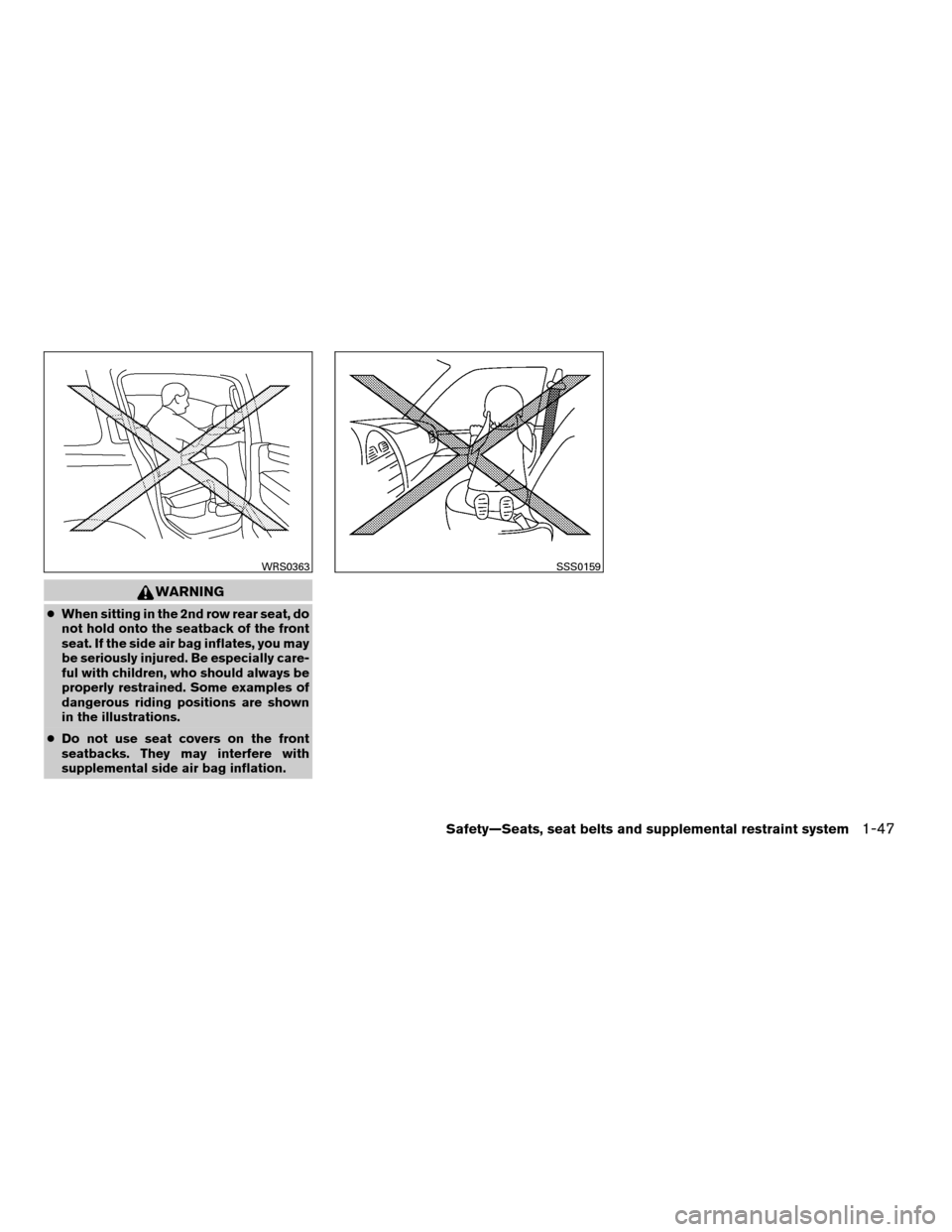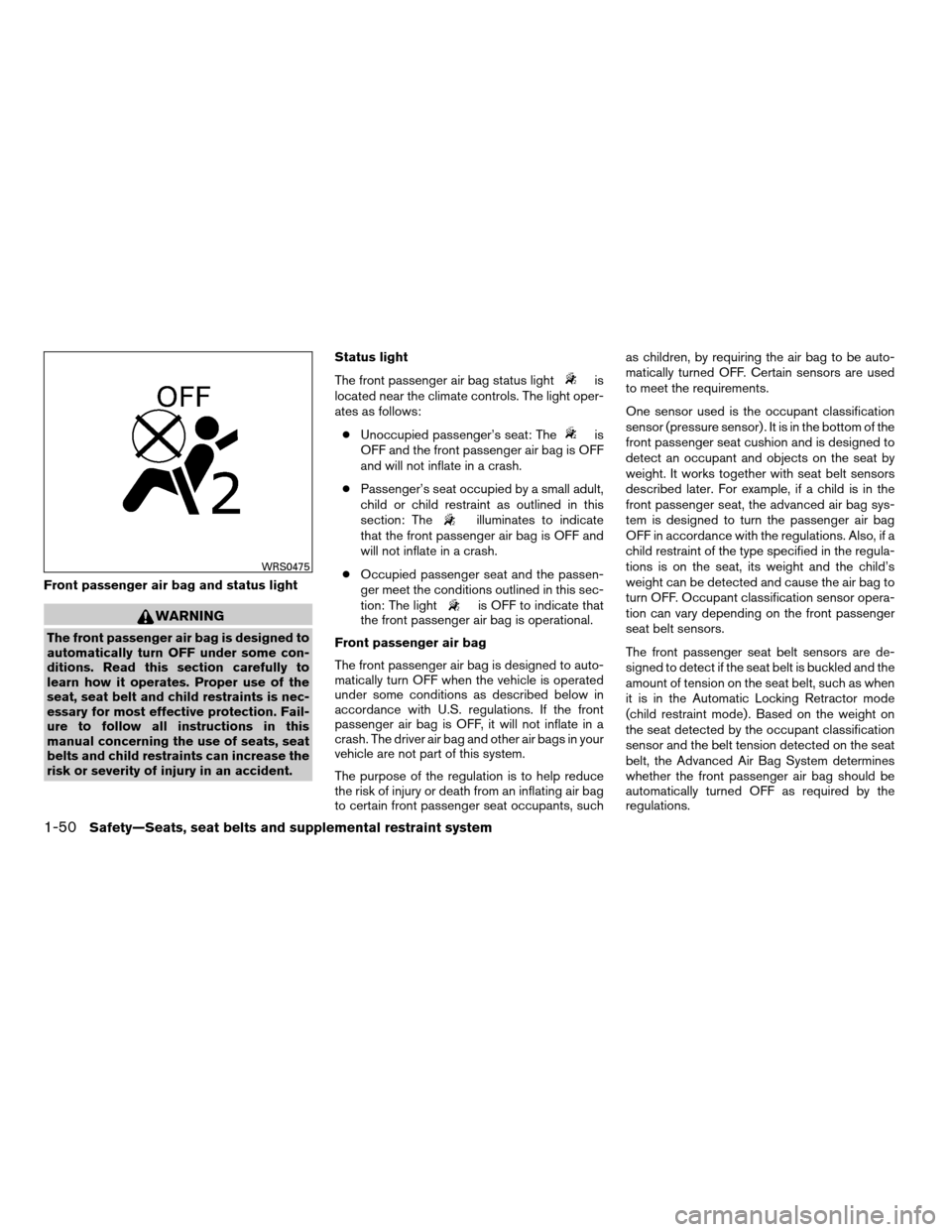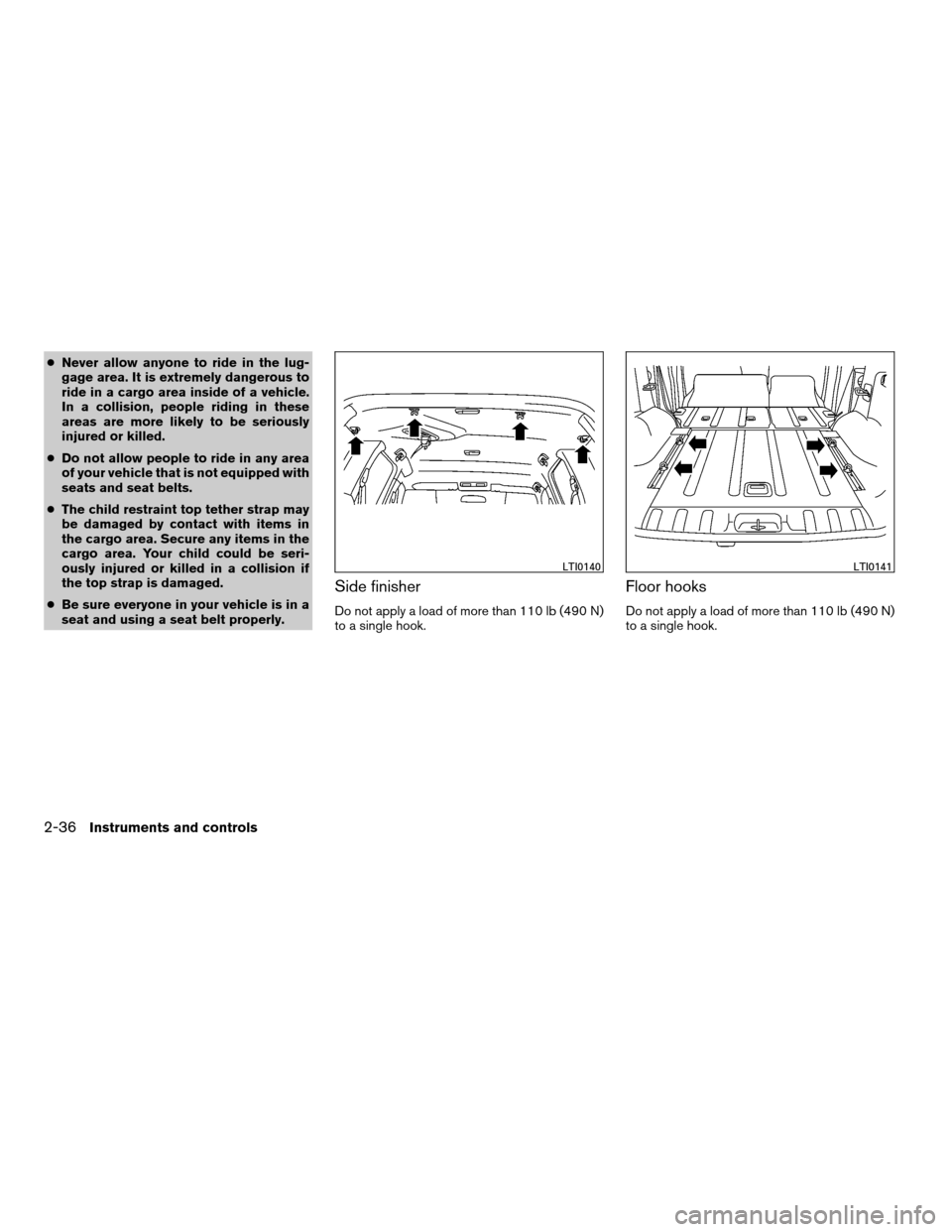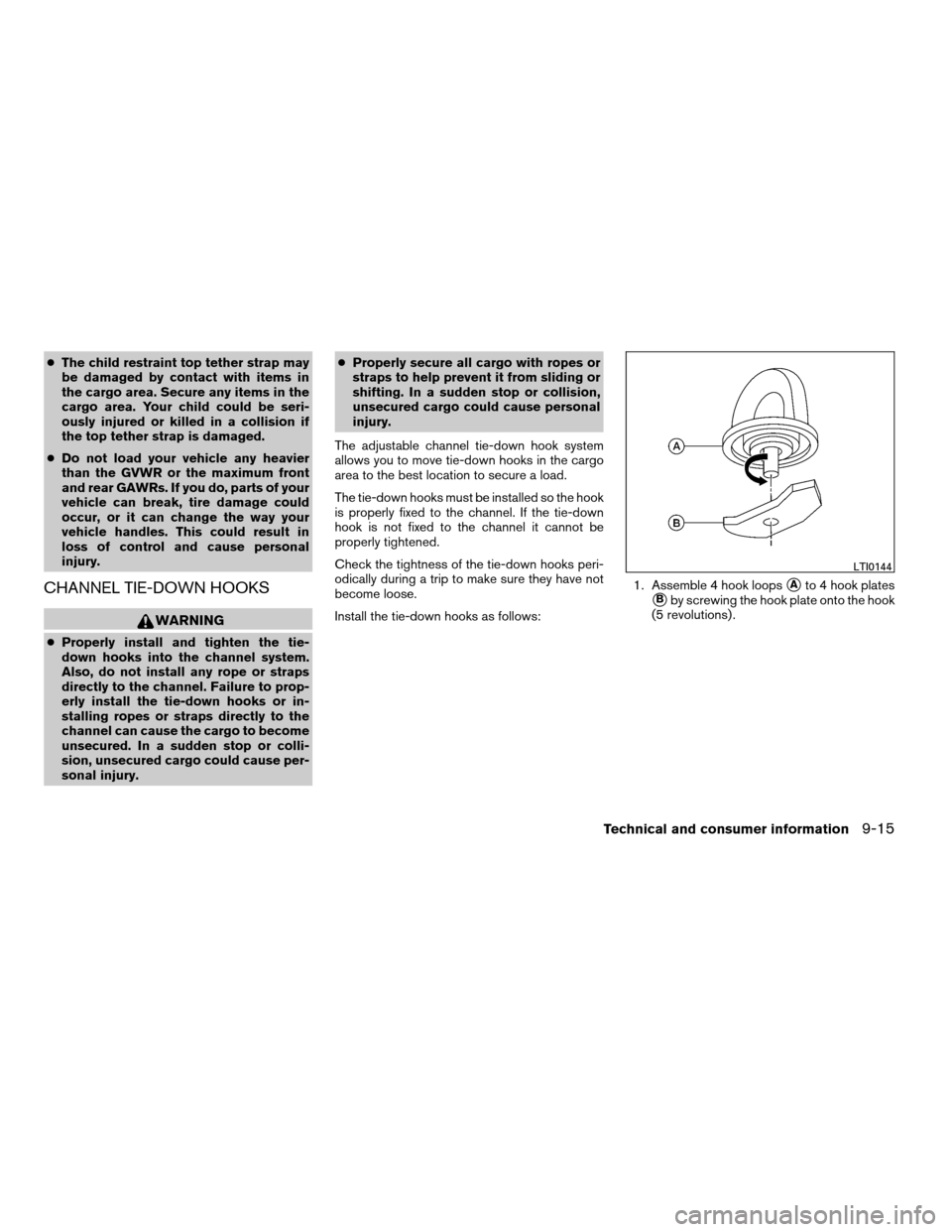2007 NISSAN XTERRA child restraint
[x] Cancel search: child restraintPage 63 of 304

WARNING
cWhen sitting in the 2nd row rear seat, do
not hold onto the seatback of the front
seat. If the side air bag inflates, you may
be seriously injured. Be especially care-
ful with children, who should always be
properly restrained. Some examples of
dangerous riding positions are shown
in the illustrations.
cDo not use seat covers on the front
seatbacks. They may interfere with
supplemental side air bag inflation.
WRS0363SSS0159
Safety—Seats, seat belts and supplemental restraint system1-47
ZREVIEW COPYÐ2007 Xterra(xtr)
Owners ManualÐUSA_English(nna)
02/27/07Ðdebbie
X
Page 66 of 304

Front passenger air bag and status light
WARNING
The front passenger air bag is designed to
automatically turn OFF under some con-
ditions. Read this section carefully to
learn how it operates. Proper use of the
seat, seat belt and child restraints is nec-
essary for most effective protection. Fail-
ure to follow all instructions in this
manual concerning the use of seats, seat
belts and child restraints can increase the
risk or severity of injury in an accident.Status light
The front passenger air bag status light
is
located near the climate controls. The light oper-
ates as follows:
cUnoccupied passenger’s seat: The
is
OFF and the front passenger air bag is OFF
and will not inflate in a crash.
cPassenger’s seat occupied by a small adult,
child or child restraint as outlined in this
section: The
illuminates to indicate
that the front passenger air bag is OFF and
will not inflate in a crash.
cOccupied passenger seat and the passen-
ger meet the conditions outlined in this sec-
tion: The light
is OFF to indicate that
the front passenger air bag is operational.
Front passenger air bag
The front passenger air bag is designed to auto-
matically turn OFF when the vehicle is operated
under some conditions as described below in
accordance with U.S. regulations. If the front
passenger air bag is OFF, it will not inflate in a
crash. The driver air bag and other air bags in your
vehicle are not part of this system.
The purpose of the regulation is to help reduce
the risk of injury or death from an inflating air bag
to certain front passenger seat occupants, suchas children, by requiring the air bag to be auto-
matically turned OFF. Certain sensors are used
to meet the requirements.
One sensor used is the occupant classification
sensor (pressure sensor) . It is in the bottom of the
front passenger seat cushion and is designed to
detect an occupant and objects on the seat by
weight. It works together with seat belt sensors
described later. For example, if a child is in the
front passenger seat, the advanced air bag sys-
tem is designed to turn the passenger air bag
OFF in accordance with the regulations. Also, if a
child restraint of the type specified in the regula-
tions is on the seat, its weight and the child’s
weight can be detected and cause the air bag to
turn OFF. Occupant classification sensor opera-
tion can vary depending on the front passenger
seat belt sensors.
The front passenger seat belt sensors are de-
signed to detect if the seat belt is buckled and the
amount of tension on the seat belt, such as when
it is in the Automatic Locking Retractor mode
(child restraint mode) . Based on the weight on
the seat detected by the occupant classification
sensor and the belt tension detected on the seat
belt, the Advanced Air Bag System determines
whether the front passenger air bag should be
automatically turned OFF as required by the
regulations.
WRS0475
1-50Safety—Seats, seat belts and supplemental restraint system
ZREVIEW COPYÐ2007 Xterra(xtr)
Owners ManualÐUSA_English(nna)
02/27/07Ðdebbie
X
Page 67 of 304

Front passenger seat adult occupants who are
properly seated and using the seat belt as out-
lined in this manual should not cause the passen-
ger air bag to be automatically turned OFF. For
small adults it may be turned OFF, however if the
occupant takes his/her weight off the seat cush-
ion (for example, by not sitting upright, by sitting
on an edge of the seat, or by otherwise being out
of position) , this could cause the sensor to turn
the air bag OFF. In addition, if the occupant
improperly uses the seat belt in the Automatic
Locking Retractor mode (child restraint mode) ,
this could cause the air bag to be turned OFF.
Always be sure to be seated and wearing the seat
belt properly for the most effective protection by
the seat belt and supplemental air bag.
NISSAN recommends that pre-teens and children
be properly restrained in a rear seat. NISSAN also
recommends that appropriate child restraints and
booster seats be properly installed in a rear seat. If
this is not possible, the occupant classification
sensor and seat belt sensors are designed to op-
erate as described above to turn the front passen-
ger air bag OFF for specified child restraints as
required by the regulations. Failing to properly se-
cure child restraints and to use the Automatic
Locking Retractor mode (child restraint mode) may
allow the restraint to tip or move in an accident or
sudden stop. This can also result in the passenger
air bag inflating in a crash instead of being OFF.See “Child restraints” earlier in this section for
proper use and installation.
If the front passenger seat is not occupied the
passenger air bag is designed not to inflate in a
crash. However, heavy objects placed on the
seat could result in air bag inflation, because of
the object’s weight detected by the occupant
classification sensor. Other conditions could also
result in air bag inflation, such as if a child is
standing on the seat, or if two children are on the
seat, contrary to the instructions in this manual.
Always be sure that you and all vehicle occupants
are seated and restrained properly.
Using the passenger air bag status light, you can
monitor when the front passenger air bag is au-
tomatically turned OFF with the seat occupied.
The light will not illuminate when the front pas-
senger seat is unoccupied.
If an adult occupant is in the seat but the passen-
ger air bag status light is illuminated (indicating
that the air bag is OFF) , it could be that the
person is a small adult, or is not sitting on the seat
properly or not using the seat belt properly.
If a child restraint must be used in the front seat,
the passenger air bag status light may or may not
be illuminated, depending on the size of the child
and the type of child restraint being used. If the air
bag status light is not illuminated (indicating that
the air bag might inflate in a crash) , it could bethat the child restraint or seat belt is not being
used properly. Make sure that the child restraint is
installed properly, the seat belt is used properly
and the occupant is positioned properly. If the air
bag status light is not illuminated, reposition the
occupant or child restraint in a rear seat.
If the passenger air bag status light will not illu-
minate even though you believe that the child
restraint, the seat belts and the occupant are
properly positioned, the system may be sensing
an unoccupied seat (in which case the air bag is
OFF) . Your NISSAN dealer can check that the
system is OFF by using a special tool. However,
until you have confirmed with your dealer that
your air bag is working properly, reposition the
occupant or child restraint in a rear seat.
The air bag system and passenger air bag status
light will take a few seconds to register a change
in the passenger seat status. For example, if a
large adult who is sitting in the front passenger
seat exits the vehicle, the passenger air bag
status light will go from OFF to ON for a few
seconds and then to OFF. This is normal system
operation and does not indicate a malfunction.
If a malfunction occurs in the front passenger air
bag system, the supplemental air bag warning
light
, located in the meter and gauges area
in the center of the instrument panel, will blink.
Have the system checked by a NISSAN dealer.
Safety—Seats, seat belts and supplemental restraint system1-51
ZREVIEW COPYÐ2007 Xterra(xtr)
Owners ManualÐUSA_English(nna)
02/27/07Ðdebbie
X
Page 110 of 304

cNever allow anyone to ride in the lug-
gage area. It is extremely dangerous to
ride in a cargo area inside of a vehicle.
In a collision, people riding in these
areas are more likely to be seriously
injured or killed.
cDo not allow people to ride in any area
of your vehicle that is not equipped with
seats and seat belts.
cThe child restraint top tether strap may
be damaged by contact with items in
the cargo area. Secure any items in the
cargo area. Your child could be seri-
ously injured or killed in a collision if
the top strap is damaged.
cBe sure everyone in your vehicle is in a
seat and using a seat belt properly.
Side finisher
Do not apply a load of more than 110 lb (490 N)
to a single hook.
Floor hooks
Do not apply a load of more than 110 lb (490 N)
to a single hook.
LTI0140LTI0141
2-36Instruments and controls
ZREVIEW COPYÐ2007 Xterra(xtr)
Owners ManualÐUSA_English(nna)
02/27/07Ðdebbie
X
Page 275 of 304

cThe child restraint top tether strap may
be damaged by contact with items in
the cargo area. Secure any items in the
cargo area. Your child could be seri-
ously injured or killed in a collision if
the top tether strap is damaged.
cDo not load your vehicle any heavier
than the GVWR or the maximum front
and rear GAWRs. If you do, parts of your
vehicle can break, tire damage could
occur, or it can change the way your
vehicle handles. This could result in
loss of control and cause personal
injury.
CHANNEL TIE-DOWN HOOKS
WARNING
cProperly install and tighten the tie-
down hooks into the channel system.
Also, do not install any rope or straps
directly to the channel. Failure to prop-
erly install the tie-down hooks or in-
stalling ropes or straps directly to the
channel can cause the cargo to become
unsecured. In a sudden stop or colli-
sion, unsecured cargo could cause per-
sonal injury.cProperly secure all cargo with ropes or
straps to help prevent it from sliding or
shifting. In a sudden stop or collision,
unsecured cargo could cause personal
injury.
The adjustable channel tie-down hook system
allows you to move tie-down hooks in the cargo
area to the best location to secure a load.
The tie-down hooks must be installed so the hook
is properly fixed to the channel. If the tie-down
hook is not fixed to the channel it cannot be
properly tightened.
Check the tightness of the tie-down hooks peri-
odically during a trip to make sure they have not
become loose.
Install the tie-down hooks as follows:1. Assemble 4 hook loops
sAto 4 hook plates
sBby screwing the hook plate onto the hook
(5 revolutions) .
LTI0144
Technical and consumer information9-15
ZREVIEW COPYÐ2007 Xterra(xtr)
Owners ManualÐUSA_English(nna)
02/27/07Ðdebbie
X
Page 293 of 304

10 Index
4WD warning light...............2-12
A
Active brake limited slip (ABLS) system
(if so equipped).................5-32
Active Head Restraint..............1-5
Air bag (See supplemental restraint
system).....................1-41
Air bag system
Front (See supplemental front impact air
bag system).................1-48
Air bag warning labels.............1-56
Air bag warning light...........1-56, 2-14
Air cleaner housing filter............8-17
Air conditioner
Air conditioner operation...........4-5
Air conditioner service............4-9
Air conditioner specification label.....9-11
Air conditioner system refrigerant and oil
recommendations..............9-6
Heater and air conditioner controls.....4-2
Servicing air conditioner...........4-9
Air flow charts..................4-6
Alarm system
(See vehicle security system).........2-18
Anchor point locations.............1-25
Antenna.....................4-27
Anti-lock brake warning light..........2-10
Anti-lock Braking System (ABS)........5-31
Audible reminders................2-18Audio system..................4-10
Compact Disc (CD) changer.......4-23
Compact disc (CD) player.........4-18
FM/AM radio with compact disc (CD)
player....................4-16
FM-AM radio with compact disc (CD)
player....................4-20
Radio....................4-10
Steering wheel audio control switch. . . .4-26
Automatic
Automatic power window switch.....2-42
Automatic transmission position indicator
light.....................2-14
Driving with automatic transmission. . . .5-12
Transmission selector lever lock
release....................5-14
AUX jack.....................4-25
B
Battery......................8-13
Charge warning light............2-11
Before starting the engine...........5-10
Belt (See drive belt)..............8-15
Block heater
Engine....................5-36
Booster seats..................1-36
Brake
Anti-lock Braking System (ABS)......5-31
Brake fluid..................8-11
Brake light (See stop light).........8-28Brake system................5-30
Brake warning light.............2-11
Brake wear indicators........2-18, 8-22
Parking brake operation..........5-17
Self-adjusting brakes............8-22
Brakes......................8-22
Break-in schedule................5-20
Brightness control
Instrument panel..............2-24
Bulb check/instrument panel..........2-10
Bulb replacement................8-28
C
Capacities and recommended
fuel/lubricants...................9-2
Car phone or CB radio.............4-27
Cargo light...................2-44
Cargo net....................2-37
Cargo (See vehicle loading information) . . .9-12
CD care and cleaning.............4-25
CD changer (See audio system)........4-23
CD player (See audio system).........4-18
Child restraint with top tether strap......1-25
Child restraints.......1-12, 1-13, 1-22, 1-24
Precautions on child
restraints............1-22, 1-30, 1-36
Top tether strap anchor point locations . .1-25
Child safety rear door lock............3-5
Chimes, audible reminders...........2-18
Cleaning exterior and interior..........7-2
ZREVIEW COPYÐ2007 Xterra(xtr)
Owners ManualÐUSA_English(nna)
02/27/07Ðdebbie
X
Page 295 of 304

G
Gascap......................3-9
Gauge
Engine coolant temperature gauge.....2-6
Engine oil pressure gauge..........2-8
Fuel gauge..................2-7
Odometer...................2-4
Speedometer.................2-4
Tachometer..................2-6
Trip computer.................2-5
Trip odometer.................2-4
Voltmeter...................2-8
General maintenance..............8-2
Glove box....................2-32
H
Hazard warning flasher switch.........2-25
Head restraints..................1-4
Active Head Restraint............1-5
Headlight and turn signal switch........2-23
Headlight control switch............2-23
Headlights....................8-27
Heater
Heater and air conditioner controls.....4-2
Heater operation...............4-4
Hill descent control switch...........2-27
Hill descent control system..........5-34
Hill start assist (HSA) system.........5-34
Hood release...................3-8
Hook
Luggage hook................2-35
Horn.......................2-26I
Ignition switch..................5-8
Immobilizer system.........2-20, 3-2, 5-10
Important vehicle information label.......9-10
In-cabin microfilter...............8-17
Increasing fuel economy............5-20
Indicator lights and audible reminders
(See warning/indicator lights and audible
reminders).....................2-9
Inside mirror...................3-12
Instrument brightness control.........2-24
Instrument panel..............0-6, 2-2
Instrument panel dimmer switch........2-24
Interior light...................2-43
ISOFIX child restraints.............1-24
J
Jump starting...................6-8
K
Key ........................3-2
Keyfob battery replacement..........8-26
Keyless entry system
(See remote keyless entry system).......3-5
L
Labels
Air conditioner specification label.....9-11C.M.V.S.S. certification label........9-10
Emission control information label.....9-10
Engine serial number............9-10
F.M.V.S.S. certification label........9-10
Vehicle identification number (VIN) plate . .9-9
Warning labels (for SRS)..........1-56
LATCH (Lower Anchors and Tethers for CHildren)
System......................1-24
License plate
Installing the license plate.........9-11
Lift gate......................3-9
Light
Air bag warning light.........1-56, 2-14
Brake light (See stop light).........8-28
Bulb check/instrument panel........2-10
Bulb replacement..............8-28
Charge warning light............2-11
Fog light switch...............2-25
Headlight and turn signal switch......2-23
Headlight control switch..........2-23
Headlights..................8-27
Interior light.................2-43
Light bulbs..................8-27
Low tire pressure warning light......2-12
Low washer fluid warning light.......2-13
Passenger air bag and status light.....1-50
Security indicator light...........2-16
Warning/indicator lights and audible
reminders...................2-9
Lights
Map lights..................2-44
Lock
Child safety rear door lock..........3-5
Door locks..................3-3
Power door locks...............3-4
Low fuel warning light.............2-12
10-3
ZREVIEW COPYÐ2007 Xterra(xtr)
Owners ManualÐUSA_English(nna)
02/27/07Ðdebbie
X
Page 296 of 304

Low tire pressure warning light........2-12
Low washer fluid warning light.........2-13
Luggage hook..................2-35
Luggage rack (see roof rack).........2-38
Luggage (See vehicle loading information) . .9-12
Luggage storage
(see vehicle loading information)........2-35
M
Maintenance
General maintenance............8-2
Inside the vehicle...............8-3
Maintenance precautions..........8-5
Outside the vehicle..............8-2
Seat belt maintenance...........1-21
Under the hood and vehicle.........8-4
Malfunction indicator light...........2-15
Manual front seat adjustment..........1-2
Manual windows................2-43
Map lights....................2-44
Map pocket...................2-33
Meters and gauges................2-3
Instrument brightness control.......2-24
Mirror
Inside mirror.................3-12
Outside mirrors...............3-13
Vanity mirror.................3-12
Multi-remote control system
(See remote keyless entry system).......3-5N
NISSAN vehicle immobilizer
system................2-20, 3-2, 5-10
O
Octane rating (See fuel octane rating).....9-4
Odometer.....................2-4
Oil
Capacities and recommended
fuel/lubricants.................9-2
Changing engine oil.............8-9
Changing engine oil filter..........8-10
Checking engine oil level..........8-8
Engine oil...................8-8
Engine oil and oil filter recommendation . .9-5
Engine oil viscosity..............9-5
Outside mirrors.................3-13
Overdrive switch................5-15
Overheat
If your vehicle overheats..........6-10
Owner’s manual order form..........9-30
Owner’s manual/service manual order
information....................9-30
P
Parking
Parking brake operation..........5-17
Parking/parking on hills...........5-29
Power
Power door locks...............3-4Power outlet.................2-29
Power rear windows............2-42
Power steering fluid.............8-11
Power steering system...........5-30
Power windows...............2-41
Rear power windows............2-42
Precautions
Maintenance precautions..........8-5
On-pavement and off-road driving
precautions..................5-5
Precautions on child
restraints............1-22, 1-30, 1-36
Precautions on seat belt usage......1-10
Precautions on supplemental restraint
system....................1-41
Precautions when starting and driving . . .5-2
Pre-tensioner seat belt system.........1-54
Push starting..................6-10
R
Radio
Car phone or CB radio...........4-27
Compact Disc (CD) changer.......4-23
FM/AM radio with compact disc (CD)
player....................4-16
FM-AM radio with compact disc (CD)
player....................4-20
Steering wheel audio control switch. . . .4-26
Readiness for inspection maintenance (I/M)
test........................9-29
Rear center seat belt..............1-16
Rear power windows..............2-42
Rear window and outside mirror defroster
switch......................2-22
10-4
ZREVIEW COPYÐ2007 Xterra(xtr)
Owners ManualÐUSA_English(nna)
02/27/07Ðdebbie
X